Library of Performing Arts at Lincoln Center Broadway Archices
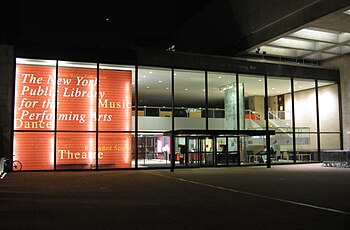
The New York Public Library for the Performing Arts' entrance from Lincoln Eye Plaza at night
The New York Public Library for the Performing Arts, Dorothy and Lewis B. Cullman Center, at forty Lincoln Center Plaza, is located in Manhattan, New York Metropolis, at the Lincoln Centre for the Performing Arts on the Upper West Side, between the Metropolitan Opera House and the Vivian Beaumont Theater. It houses i of the globe's largest collections of materials relating to the performing arts.[ane] [2] [3] It is one of the four research centers of the New York Public Library's Research library system, and it is also one of the branch libraries.
History [edit]
Founding and original configuration [edit]

Originally the collections that formed The New York Public Library for the Performing Arts (LPA) were housed in two buildings. The Research collections on Dance, Music, and Theatre were located at the New York Public Library Main Branch, now named the Stephen A. Schwarzman Edifice, and the circulating music drove was located in the 58th Street Library.
A dissever center to house performing arts was starting time proposed by Carleton Sprague Smith (chief of the Music Division) in a 1932 report to the library administration, "A Worthy Music Eye for New York."[4] (At the time, dance materials and sound recordings were all function of the Music Sectionalisation.) In that location were attempts to create partnerships with Rockefeller Center (under structure at the time), the Museum of Modern Art, and the Metropolitan Museum of Art (to which New York University wanted to join equally a partner). During the tardily 1930s and early 1940s, the Music Sectionalisation produced a plan of concerts (based on the model of the Library of Congress concerts in Coolidge Auditorium). These concerts were often held in conjunction with the Metropolitan Museum of Art and Juilliard Schoolhouse, and the program grew to include Lectures from New York University staff.
Afterwards Lincoln Centre was incorporated in 1956, an early on mention of a possible "library and museum of the performing arts" appeared in June 1957.[5] Information technology was envisioned that a library-museum would serve to "interpret and illuminate the entire range of the performing arts."[6] By December of that year, the library had go an accustomed component of Lincoln Eye planning and fundraising.[7] Recalling his earlier reports, Smith produced a new report arguing for a motion to Lincoln Center. Library administration officially canonical of the move in June 1959.[viii]
The building housing the library's inquiry collections and the Vivian Beaumont Theater was the third building to be opened at Lincoln Center.[nine] Original plans conceived the library as a split building, merely prohibitive costs necessitated a combination of the Library and the Theater. As built, the Theater forms the cardinal core of the building, the 1st and 2nd floors occupying the southern and western sides, and the third floor enquiry collections providing a roof. Noted modernist builder Gordon Bunshaft, of the firm of Skidmore, Owings and Merrill (SOM) designed the interiors, and SOM consulted with Eero Saarinen and Associates (architect for the Vivian Beaumont Theater) on the exteriors.[x] The Claire Tow Theater (belonging to Lincoln Center Theater) was built on the roof of the Library and opened in June 2012.
The third floor, housing the research collections, opened to the public on July 19.[ten] The unabridged library was opened to the public on Nov 30, 1965, the 4th building to open at Lincoln Eye.[11] At its opening, it was chosen "Library and Museum of the Performing Arts." The Library'due south museum component was named the Shelby Cullom Davis Museum in laurels of an investment banker who contributed $1 1000000 to Lincoln Center for museum purposes.[11]
At its opening, the Library's main entrance hall at the Lincoln Heart Plaza entrance housed a bookstore, a film viewing area, and a listening area. The second floor included a children'due south performing arts collection as well as the Hecksher Oval, an enclosed space that could arrange story-telling. Prior to the 2001 renovation, the children's collection was relocated to the Riverside Co-operative. The Hecksher Oval was removed equally office of the renovation.
The Shelby Cullom Davis Museum spaces included minor and separate areas in the Trip the light fantastic, Music, Audio archive and Theater research divisions. Bigger galleries were the Vincent Astor Gallery on the second floor, and galleries on the lower level and 2d floor.
2001 renovation [edit]
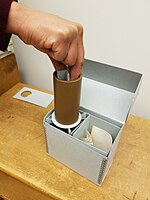
From 1998 through 2001, the building was closed due to a $38 1000000 renovation project designed past Polshek Partnership. (The renovation was unrelated to the Lincoln Center renovations which commenced soon afterward 2001.) During this time, the research collections were serviced from the NYPL's Annex (at tenth avenue and 43rd street), and the circulating collections were housed at the Mid-Manhattan Library at 40th Street and Fifth Avenue. LPA reopened to the public on October 29, 2001, with its building newly named Dorothy and Lewis B. Cullman Center after a gift from the Cullmans (Dorothy was a trustee until she died; Lewis is withal a trustee).[12]
During the renovation, the library was wired to enable installation of numerous computers on each floor. There are nearly 200 publicly accessible computers in the building.[13] [ better source needed ] Most are restricted to use of the library catalog and electronic databases or viewing the library's audiovisual cloth, but a few provide full Cyberspace admission. The renovation likewise created a Technology Training Room, with twelve desktop computers for users and 1 for a instructor, as well as a projection screen.
Upon the building'southward original opening in 1965, each research division had a separate reading room. The renovation removed these and consolidated public areas into a unmarried unified public reading area, with divide rooms for the Theater on Moving-picture show and Tape Archive (its screening room named for Lucille Lortel) and Special Collections (its room named for Katharine Cornell and Guthrie McClintic). After the Special Collections reading room was moved into a portion of the main reading surface area of the 3rd floor, while a screening room for films held by the Jerome Robbins Trip the light fantastic Segmentation and the Reserve Film and Video Collection (originally part of the Donnell Media Center, but absorbed into the Drove in 2008) took its identify. Meanwhile, gallery infinite for the museum was consolidated into two main gallery spaces with smaller areas for brandish of other items. The Donald and Mary Oenslager Gallery is located on the first floor, next to the Lincoln Plaza archway, while the Vincent Astor Gallery (formerly on the second flooring) is now located on the lower level, adjacent to the Amsterdam Artery entrance. A pocket-sized area near the Lincoln Centre Plaza entrance houses caricaturist Al Hirschfeld's desk-bound and chair. The main corridors on the first and second floors are used for smaller exhibitions. The tertiary flooring has numerous display cases highlighting rotating displays of thematic groupings of artifacts from the collections.
The renovation was not without detractors. Critic Joseph Horowitz criticized the third floor in particular. Where previously each partition had its own reading room, the renovation united all public reading areas into i room, resulting in less intimacy and more noise.[xiv] Edmund Morris characterized the Special Collections reading room as "a charmless space...[which] exudes a dispirited air of neglect."[15]
Inquiry collections [edit]
From its inception, LPA has had both a research component (funded mostly with private money) and a branch library component (funded with significant money from New York Urban center, the balance coming from private contributions).
Materials and formats [edit]

File cabinets contain over a million clippings at LPA

In addition to published works (for instance, books, periodicals, and scores), the research divisions collect an enormous amount of unique textile: Archival material (material that was created by or that one time belonged to an individual or organization), text manuscripts, music manuscripts, dance notation scores, typescripts, prompt books, posters, original prepare and costume designs, programs, and other ephemera are just some of the major categories of materials. The library's collection of sound recordings is in all formats that in themselves trace the history and development of sound recording.
The library has 500,000 folders containing clippings on a multifariousness of people and subjects pertaining to the performing arts. These clippings can sometimes provide a beginning to those at the initial stage of their research. The library likewise collects a variety of iconography in various forms: photographs, lithographs, engravings, drawings, and others. A recent internal report estimated that LPA holds approximately 4.5 million photographs, including the recently caused collection of New York photographer Martha Swope, itself belongings 1 meg photographs.
Much of this non-book material was not initially in the online catalog.[16] Some materials are attainable through in-house card files and indexes. Policy since changed to bring as much of the material as possible into the master catalog, and by 2013, most of information technology was attainable in the catalog. Considering of the enormous book of material, some classes of it, such as the clipping files, has never been inventoried, although it is arranged in a retrievable manner with an alphabetical or chronological organisation. Unlike most U.S. public libraries, the enquiry collections stacks are located in non-public areas and are not available for browsing. Patrons must make up one's mind what they want to view, make full out call slips, and submit the slips to library staff. Library staff then retrieves the material for the patron.
The holdings of LPA are divided past subject into divisions, which contain a number of special centers.
Music Division [edit]
The Music Partition, every bit a founding segmentation of The New York Public Library, is the oldest of all the divisions at LPA. Its origins stalk from the private library of banker Joseph William Drexel. Upon his death in 1888, his valuable library of 5,542 volumes and 766 pamphlets, known as the Drexel Collection, became part of the Lenox Library. The Astor Library as well had an endowment that helped with the buy of music. In 1895, upon the Lenox Library's consolidation with the Astor Library, the Music Division became one of the first subject divisions of The New York Public Library.[17] [18]
According to The New Grove Dictionary of Jazz, the library has particular strong manuscript holdings in jazz, These include 400 of Benny Goodman's arrangements, and the arrangements made by Sy Oliver for musicians including Knuckles Ellington, Jimmie Lunceford, and Tommy Dorsey. It holds working scores of works by Ellington, and by Charles Mingus besides equally extensive microlim copies of Mingus' manuscripts.[19]
Classical music manuscript holding include manuscripts past Bach, Johannes Brahms, Franz Liszt, Glinka, Handel, Haydn, Korngold, Mozart, Paganini, Schubert, and Schumann.[twenty]
Billy Rose Theatre Division [edit]

The Library has been collecting theatrical materials for years prior to 1931, when the executors of David Belasco'southward estate offered the producer's holdings on the status that a sectionalisation exist created. The Theatre Collection (as it was initially known) began on September 1, 1931. The partitioning opened at Lincoln Center as the Theatre Drove. In 1956 the theatre drove of the New York Public Library was recognized with a Special Tony Award. In 1979, information technology was renamed the Baton Rose Theatre Partitioning, honoring a financial gift from the lyricist/producer's foundation. Information technology is at present the largest enquiry division at the library, with holdings primarily on the theatre, and increasing on flick, with some collections on the related subjects of vaudeville, magic, puppetry, and the circus.[ citation needed ] The Theater of Movie and Tape Archive is administratively within the sectionalization.
The Theatre division includes the Theatre on Motion picture and Tape Archive (TOFT) which produces video recordings of New York and regional theater productions, and provides research access at its Lucille Lortel screening room. The collection is considered one of the most comprehensive collections of videotaped theater productions in the earth.[21] Athenaeum modeled on TOFT include the Museum of Performance & Design in San Francisco, the Washington Surface area Performing Arts Video Archive established in Washington, D.C., and the National Video Archive of Performance in London. The core of the drove consists of alive recordings of Broadway and Off-Broadway productions, with some additional productions from professional regional theaters. The Archive also records interviews and dialogues with notable theater professionals. In add-on to alive performances, commercial recordings of theater-related films, documentaries, and television programs are also included in the collection. Currently betwixt fifty and threescore live recordings are produced each year, roofing most important productions. As of fall of 2016, the collection included 7,901 titles.[22]
Jerome Robbins Trip the light fantastic toe Division [edit]
The Jerome Robbins Trip the light fantastic toe Division began in 1944 under the auspices of Genevieve Oswald.[23] Originally trip the light fantastic materials were part of the Music Division (when it was known as the "Dance Drove"), just its growth necessitated hiring a full-time staff member in 1947.[24] Acquisitions were augmented by gifts of papers of Ted Shawn and Ruth St. Denis, Doris Humphrey, Charles Weidman, and Hanya Holm. With the souvenir of a collection of Walter Toscanini in accolade of his deceased wife, Cia Fornaroli (a dancer), the Trip the light fantastic toe Drove became an internationally known repository.[24] Due to its subsequent growth and increasing importance, the collection was formally recognized as a separate division on January one, 1964.[25]
Ane of the division's most meaning resources is the Jerome Robbins Archive of the Recorded Moving Epitome. Endowed with a gift from Jerome Robbins, this annal collects and preserves moving images of dance, making them available to researchers. The Annal has received many gifts from dancers and choreographers and contains many privately made films and video.[26]
The Division's oral history program began formally in 1965. These oral histories are particularly valuable since they provide information, history and context not more often than not bachelor in published sources.[27]
Reserve Motion picture and Video [edit]
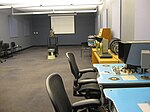
Screening room for the Reserve Film and Video drove; moviola and Steenbeck equipment are on the right
Though not technically a part of the Inquiry divisions, the Reserve Film and Video Collection (formerly the Donnell Media Center) is serviced from the tertiary flooring. For film and video that must be viewed onsite, there is a screening room (large plenty for classes) equipped with a 16 mm projector. There are also moviolas and Steenbeck equipment, permitting close frame-past-frame examination and analysis.
Rodgers and Hammerstein Archives of Recorded Audio [edit]
The origins of the Rodgers and Hammerstein Archives of Recorded Sound can be traced to a gift of 500 78-rpm records by Columbia Records in 1937 to the Music Division. Successive gifts by record companies and individuals led to the formal creation of a separate division with the opening of the edifice at Lincoln Eye in 1965. It was named in substitution for a private donation from the Rodgers and Hammerstein organization.[28] Radio station WQXR donated xi,000 78 rpm recordings in 1966.[29] Carleton Sprague Smith envisioned the purpose of the audio annal as "stimulating involvement among recording and broadcasting executives, too as other arts institutions that had potential for playing a cooperative role."[30] Resources include the Rigler-Deutsch Index, which lists of library'southward extensive holdings of 78 rpm records.
Branch (Circulating) Collections [edit]
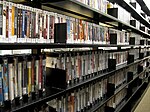
A portion of the circulating DVDs
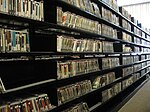
The beginnings of the circulating music collection are due in great office to its commencement caput librarian, Dorothy Lawton.[31] Lawton took office in the institution of the music collection at the 58th Street Library in 1920, beginning with a drove of ane,000 books and scores. In 1924, the circulating music collection was officially established as part of the 58th Street Library.[32] Her passion for dance enabled her to get unusual publications, so much that trip the light fantastic critic John Martin complimented her on the growing collection of dance books.[33]
In 1929, the 58th Street Library began a collection of recordings start with gifts from Victor and Columbia records, amounting to 500 records. Upon edifice a listening booth, Lawton reported that past 1933, the listening berth was constantly booked two weeks in accelerate.[34]
During World War II, she established a concert series for servicemen on Sundays from three–7 PM. Servicemen could request selections of their pick and could also participate in playing chamber music with instruments that had been loaned to the Library. She established the Orchestra Drove, a set of scores and parts that could be loaned to groups for functioning. Currently, the Orchestra Collection loans parts to over 2,000 works.[35]
Upon Lawton'southward retirement in 1945, primary music critic of The New York Times Olin Downes complimented her on the development of the 58th Street Library, and remarked on her achievements such as attracting donors and enlisting the business organization and assistance of professional person musicians.[36] (Many of the rare items that were gifts to the 58th Street Co-operative were subsequently moved to the Music Division.)
After retiring, Lawton returned to the country of her nativity, England, and help organize a newly created music collection at Central Music Library of the Buckingham Palace Road Library (today the Westminster Music Library), modeling the new library on the one she established at 58th Street.[31] [37] [38] Currently, the Circulating collections loan books on music, dance, theater, film, and arts administration. They too loan scores, scripts, CDs, videotapes, DVDs, and sets of orchestral parts.
Shelby Cullom Davis Museum [edit]

A display wall of the Shelby Cullom Davis Museum
The museum component of LPA takes the class of exhibitions in its two principal exhibition spaces, The Donald and Mary Oenslager Gallery and the Vincent Astor Gallery, also as a walled area in the plaza entrance, and additionally display cases distributed throughout the edifice. Among the purposes of the exhibitions is to evidence to all visitors that the millions of items belonging to the library are not for the exclusive employ of scholars simply for anyone who walks in the door.[39] Exhibitions highlights items from the library's collections and keep the proper name of the library before the public, attracting new and potential donations.[40]
Since the late 1990s, NYPL's exhibitions plan has added online exhibitions. Online exhibitions serve equally an extension of concrete exhibitions, adding more cloth or allowing a greater depth of exploration.
Public programs [edit]
Public programs are costless of charge and have place in the 202-seat Bruno Walter Auditorium located on the lower level. The auditorium is used several times a calendar week for musical performances, film screenings and lectures.[41]
Encounter also [edit]
- Carleton Sprague Smith
Further reading [edit]
- Sydney Brook, "Carleton Sprague Smith and the Shaping of a Corking Music Library: Harbinger of a Center for the Performing Arts (Recollections of a Staff Fellow member)" in: Libraries, History, Diplomacy, and the Performing Arts: Essays in Award of Carleton Sprague Smith. Festschrift Series no. 9. Stuyvesant, NY: Pendragon Press, 1991. ISBN 978-0-945193-13-v
- Miller, Philip 50. and Frank Campbell, "How the Music Partition Grew-A Memoir (parts 1–2)." Notes vol. 35, no. 3 (March 1979), pp. 537–555; part 3: vol. 36, no. 1 (September 1979), pp. 76–77; role iv: Vol. 38, No. 1 (September 1981), pp. xiv–41.
- Williams, Sam P. Guide to the Inquiry Collections of the New York Public Library. New York: New York Public Library, 1975. ISBN 0-8389-0125-5
References [edit]
- ^ The New York Public Library. "New York Public Library for the Performing Arts, Dorothy and Lewis B. Cullman Center". Nypl.org. Retrieved Feb 12, 2013.
- ^ New York Public Library for the Performing Arts, Dorothy and Lewis B. Cullman Center, accessed September four, 2011.
- ^ "New York Public Library for the Performing Arts | twoscore Lincoln Center Plaza". Timeout.com. October five, 2010. Retrieved February 12, 2013.
- ^ Brook, p. 20ff.
- ^ Howard Taubman, "Borough Pride: Metropolis Officials Should Work for Lincoln Center equally a Municipal Necessity," The New York Times (June 2, 1957), p. 121.
- ^ Beck, p. 38.
- ^ "Committee Ready To Seek Arts Fund," The New York Times (Dec ii, 1957), p. 29.
- ^ Beck, p. 39.
- ^ Milton Esterow, "Beaumont Theater Opens at Lincoln Center," The New York Times (October 13, 1965), p. 1.
- ^ a b Allen Hughes, "Library and Museum 01 the Arts At Lincoln Center Prepare Presently," The New York Times (October 21, 1965), p. 57.
- ^ a b "Library-Museum of the Arts Opens at Lincoln Center," The New York Times (December 1, 1965), p. 55.
- ^ Mel Gussow, "Drape Going Up at the Performing Arts Library", The New York Times (Oct 11, 2001), p. E1.
- ^ Personal advice from IT staff, May 12, 2011.
- ^ Joseph Horowitz, "Placidity, Delight. This Is a Library Subsequently All", The New York Times (January 27, 2002), p. A31.
- ^ Edmund Morris, "Sacking a Palace of Culture", The New York Times (April 21, 2012), p. SR7.
- ^ A 1995 brochure indicated that 80% of the materials at LPA were not in the online itemize.
- ^ Williams, p. 142.
- ^ Much of the content of this section is derived from the thorough history of the Music Partition through 1981 in a four-part commodity: Philip L. Miller, Frank C. Campbell, Otto Kinkeldey, "How the Music Partitioning of the New York Public Library Grew-A Memoir," Notes Vol. 35, No. 3 (March 1979), pp. 537–555 (parts 1–2), Vol. 36, No. 1 (September 1979), pp. 65–77 (part 3), Vol. 38, No. 1 (September 1981), pp. 14–41 (part 4).
- ^ "Libraries and archives." The New Grove Dictionary of Jazz, 2d ed.. Grove Music Online. Oxford Music Online. Oxford University Press, accessed March 28, 2013, [1].
- ^ Rita Benton. "Libraries." Grove Music Online. Oxford Music Online. Oxford Academy Press, accessed March 28, 2013, [2]
- ^ ["After the Final Curtain, Act 2"], The New York Times (June 9, 2013).
- ^ 2016 Annual Report
- ^ Clive Barnes, "Trip the light fantastic toe: Collection Moves to New Home," The New York Times (January iv, 1966), p. 21.
- ^ a b Williams, p. 151.
- ^ Philip Fifty. Miller, "How the Music Segmentation Grew-A Memoir," Notes vol. 35, no. three (March 1979), p. 549.
- ^ Williams, pp. 151, 154.
- ^ Williams, p. 155.
- ^ Williams, p. 149.
- ^ "Lincoln Centre Receives eleven,000 Disks From WQXR," The New York Times (June 9, 1966), p. 53.
- ^ David Hall, "The Rodgers and Hammerstein Archives of Recorded Audio, The New York Public Library at Lincoln Eye," in: Libraries, History, Diplomacy, and the Performing Arts: Essays in Honor of Carleton Sprague Smith, Festschrift Series no. nine (Stuyvesant, NY: Pendragon Press, 1991), p. 43
- ^ a b "Dorothy Lawton, Librarian, 85, Dies," The New York Times (February 21, 1960), p. 92.
- ^ Circulating Music Drove, accessed September 5, 2011.
- ^ John Martin, "The Dance: A Treasury: Important New Volumes Added to Growing Drove at Library", The New York Times (October 4, 1931), p. 116.
- ^ Compton Pakenham, "Review of Newly Recorded Music," The New York Times (April 15, 1934), p. X6.
- ^ website, accessed September nine, 2011.
- ^ Olin Downes, "Librarian Retires: A Tribute to Dorothy Lawton-Her Contribution to Our Musical Life," The New York Times (July 8, 1945), p. 18.
- ^ Olin Downes, "London Library: Music Institution Formed Forth Lines of 58th Street Co-operative Here," The New York Times (Baronial ten, 1947), p. X6.
- ^ "London Library," The New York Times (November fourteen, 1948), p. X7.
- ^ Eleanor Blau, "Performing Arts Library Celebrates," The New York Times (May 29, 1991), p. C14.
- ^ Frank C. Campbell, "How the Music Segmentation of the New York Public Library Grew-A Memoir, function 4," Notes vol. 38, no. 1 (September 1981), p. 15.
- ^ About Public Programs at the Library for the Performing Arts.
External links [edit]
Coordinates: 40°46′22″Northward 73°59′03″West / twoscore.772831°Northward 73.984238°West / 40.772831; -73.984238
sebastianhappereand.blogspot.com
Source: https://en.wikipedia.org/wiki/New_York_Public_Library_for_the_Performing_Arts
0 Response to "Library of Performing Arts at Lincoln Center Broadway Archices"
Post a Comment